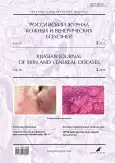Клинические и дерматоскопические признаки атипичной меланомы
- Авторы: Сайфуллина В.А.1, Гаранина О.Е.1, Клеменова И.А.1, Ускова К.А.1, Миронычева А.М.1, Сайфуллин А.П.1, Шливко И.Л.1
-
Учреждения:
- Приволжский исследовательский медицинский университет
- Выпуск: Том 28, № 2 (2025)
- Страницы: 134-142
- Раздел: ДЕРМАТООНКОЛОГИЯ
- URL: https://bakhtiniada.ru/1560-9588/article/view/313059
- DOI: https://doi.org/10.17816/dv645376
- EDN: https://elibrary.ru/BTWHWH
- ID: 313059
Цитировать
Аннотация
Обоснование. Меланома ― одна из самых агрессивных опухолей кожи, заболеваемость которой увеличивается повсеместно. Дерматоскопическое разнообразие и имитация других опухолей кожи приводят к ошибкам диагностики и выбору неверной тактики ведения пациента.
Цель исследования ― выявить клинические и дерматоскопические признаки атипичной инвазивной меланомы, имитирующей другие доброкачественные и злокачественные новообразования кожи, в зависимости от толщины новообразования.
Материалы и методы. Проанализировано 3957 медицинских карт пациентов, обратившихся в центр с новообразованиями кожи, по которым выявлено 270 случаев меланомы, из них 57, составивших основную группу, имели клиническое и патоморфологическое несоответствие предварительного и окончательного диагнозов (атипичные меланомы). Пациенты основной группы были разделены на подгруппы по толщине новообразования с использованием классификации Бреслоу ― тонкие (<0,8 мм; n=37) и толстые (≥0,8 мм; n=20). В контрольную группу вошли пациенты с типичной меланомой (n=71).
Результаты. Атипичные тонкие меланомы в сравнении с типичными меланомами чаще встречались у пациентов молодого возраста (40 против 57 лет; p=0,000) и характеризовались меньшим средним диаметром (8 против 10 мм; p=0,000). Клинически случаи атипичной тонкой меланомы отличались такими признаками, как асимметричность (83,7% против 100%; p=0,011), полихромность (70,1% против 89,2%; p=0,043), ровные границы (27,1% против 8,1%; p=0,032); случаи атипичной толстой меланомы отличались асимметричностью (71% против 97,1%; p=0,004) и ровными границами (60% против 14,7%; p=0,001). Дерматоскопически случаи атипичной тонкой меланомы характеризовались полихромностью (81,1% против 100%; p=0,005), атипичной пигментной сетью (67,6% против 94,6%; p=0,003), белыми полосами (16,3% против 40,5%; p=0,020), бесструктурной областью серого/серо-голубого цвета (54,1% против 78,4%; p=0,027), точечными (27,1% против 5,4%; p=0,012) и/или клубочковыми (13,5% против 0; p=0,021) сосудами, в то время как для атипичной толстой меланомы были характерны атипичная пигментная сеть (25% против 79,4%; p=0,000), точки/глобулы по периферии (15% против 41,2%; p=0,045), а также бесструктурная область чёрного/тёмно-коричневого/коричневого (75% против 97,1%; p=0,013), серого/серо-голубого (55% против 94,2%; p=0,001) и/или красного/розового (65% против 88,2%; p=0,041) цвета.
Заключение. Атипичные меланомы отличаются статистически значимыми клиническими и дерматоскопическими признаками, не характерными для типичной меланомы.
Ключевые слова
Полный текст
Открыть статью на сайте журналаОб авторах
Виктория Алексеевна Сайфуллина
Приволжский исследовательский медицинский университет
Автор, ответственный за переписку.
Email: dr.saifullina@gmail.com
ORCID iD: 0000-0002-1502-5505
SPIN-код: 2929-3469
аспирант кафедры кожных и венерических болезней
Россия, 603000, Нижний Новгород, ул. Семашко, д. 22Оксана Евгеньевна Гаранина
Приволжский исследовательский медицинский университет
Email: oksanachekalkina@yandex.ru
ORCID iD: 0000-0002-7326-7553
SPIN-код: 6758-5913
доктор медицинских наук, доцент
Россия, 603000, Нижний Новгород, ул. Семашко, д. 22Ирина Александровна Клеменова
Приволжский исследовательский медицинский университет
Email: iklemenova@mail.ru
ORCID iD: 0000-0003-1042-8425
SPIN-код: 8119-2480
доктор медицинских наук, профессор, проф. каф. кожных и венерических болезней
Россия, 603000, Нижний Новгород, ул. Семашко, д. 22Ксения Александровна Ускова
Приволжский исследовательский медицинский университет
Email: k_balyasova@bk.ru
ORCID iD: 0000-0002-1000-9848
SPIN-код: 1408-3490
кандидат медицинских наук
Россия, 603000, Нижний Новгород, ул. Семашко, д. 22Анна Михайловна Миронычева
Приволжский исследовательский медицинский университет
Email: mironychevann@gmail.com
ORCID iD: 0000-0002-7535-3025
SPIN-код: 3431-7447
Ассистент
Россия, 603000, Нижний Новгород, ул. Семашко, д. 22Александр Петрович Сайфуллин
Приволжский исследовательский медицинский университет
Email: sayfullin-a.p@mail.ru
ORCID iD: 0000-0003-0108-398X
SPIN-код: 5698-5841
Врач-нейрохирург
Россия, 603000, Нижний Новгород, ул. Семашко, д. 22Ирена Леонидовна Шливко
Приволжский исследовательский медицинский университет
Email: irshlivko@gmail.com
ORCID iD: 0000-0001-7253-7091
SPIN-код: 8301-4815
доктор медицинских наук
Россия, 603000, Нижний Новгород, ул. Семашко, д. 22Список литературы
- Okhovat JP, Beaulieu D, Tsao H, et al. The first 30 years of the American Academy of Dermatology skin cancer screening program: 1985–2014. J Am Acad Dermatol. 2018;79(5):884–891.e3. doi: 10.1016/j.jaad.2018.05.1242
- Lallas A, Longo C, Manfredini M, et al. Accuracy of dermoscopic criteria for the diagnosis of melanoma in situ. JAMA Dermatol. 2018;154(4):414–419. doi: 10.1001/jamadermatol.2017.6447
- Tamai I, Ohashi R, Nezu JI, et al. Molecular and functional characterization of organic cation/carnitine transporter family in mice. J Biol Chem. 2000;275(51):40064–40072. doi: 10.1074/jbc.M005340200
- Steding-Jessen M, Hölmich LR, Chakera AH, et al. Thin or early melanoma, risk factors and associated mortality. Dan Med J. 2022;69(9):A01220020.
- Lorentzen HF, Weismann K, Larsen FG. Dermatoscopic prediction of melanoma thickness using latent trait analysis and likelihood ratios. Acta Derm Venereol. 2001;81(1):38–41. doi: 10.1080/000155501750208173
- Argenziano G, Fabbrocini G, Carli P, et al. Clinical and dermatoscopic criteria for the preoperative evaluation of cutaneous melanoma thickness. J Am Acad Dermatol. 1999;40(1):61–68. doi: 10.1016/s0190-9622(99)70528-1
- Argenziano G, Fabbrocini G, Carli P, et al. Epiluminescence microscopy: Criteria of cutaneous melanoma progression. J Am Acad Dermatol. 1997;37(1):68–74. doi: 10.1016/s0190-9622(97)70213-5
- Reiter O, Kurtansky N, Nanda JK, et al. The differences in clinical and dermoscopic features between in situ and invasive nevus-associated melanomas and de novo melanomas. J Eur Acad Dermatol Venereol. 2021;35(5):1111–1118. doi: 10.1111/jdv.17133
- Hayashi K, Koga H, Uhara H, Saida T. High-frequency 30-MHz sonography in preoperative assessment of tumor thickness of primary melanoma: Usefulness in determination of surgical margin and indication for sentinel lymph node biopsy. Int J Clin Oncol. 2009;14(5):426–430. doi: 10.1007/s10147-009-0894-3
Дополнительные файлы









